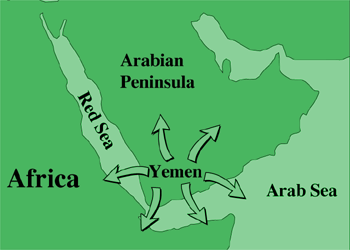
Yemen: Origin of all Arabs [Archives:2001/07/Reportage]
February 12 2001
By: Luay Ahmed Masood
The following is an excerpt from a book that won 1st place in ‘seerah’ of the Prophet (saw) from the board of scholars in Mecca, Ar-Raheeq Al-Makhtum (The Sealed Nectar): A biography of the Prophet (saw)

Arab Tribes:
Arab kinfolks have been divided according to lineage into three groups:
1. Perishing Arabs: The ancient Arabs, of whose history little is known, and among whom were the Ad, Thamûd, Tasam, Jadis, Emlaq and others.
2. Pure Arabs: Who originated from the progeny of Ya’rub bin Yashjub bin Qahtan. They were also called Qahtanian Arabs.
3. Arabized Arabs: Who originated from the progeny of Ishmael. They were also called ‘Adnanian Arabs.
The pure Arabs – the people of Qahtan – originally lived and came from Yemen and comprised many tribes, two of which were very famous:
1. Kahlan: The most famous of whose groups were Hamdan, Anmar, Tai’, Mudhhij, Kinda, Lakhm, Judham, Azd, Aws, Khazraj and the descendants of Jafna – the kings of old Syria.
2. Himyar: The most famous of whose groups were Zaid Al-Jamhur, Quda’a and Sakasic.
Kahlan groups emigrated from Yemen to dwell in different parts of the Arabian Peninsula prior to the Great Flood (Sail Al-‘Arim of Ma’rib Dam), due to the failure of trade owing to Roman control of both sea and land trade routes following the Roman occupation of Egypt and Syria.
Naturally enough, the competition between the Kahlan and the Himyar led to the evacuation of the first and the settlement of the second in Yemen.
The emigrating groups of the Kahlan can be divided into four groups:
1. Azd: Who, under the leadership of ‘Imran bin ‘Amr Muzaiqba’, wandered in Yemen, sent pioneers and finally headed northwards. Details of their emigration can be summed up as follows:
Tha’labah bin ‘Amr left his tribe Al-Azd for Hijaz and dwelt between Tha’labiyah and Dhi Qar. When he gained strength, he headed for Madinah where he stayed. Of his descendants are Aws and Khazraj, sons of Haritha bin Tha’labah.
Haritha bin ‘Amr, known as Khuza’a, wandered with his people in Hijaz until they came to Mar Az-Zahran. Later, they conquered the Haram, and settled in Makkah after having driven away its people, the tribe of Jurhum.
‘Imran bin ‘Amr and his folks went to ‘Oman where they established the tribe of Azd whose children inhabited Tihama and were known as Azd-of-Shanu’a.
Jafna bin ‘Amr and his family, headed for Syria where he settled and set up the kingdom of Ghassan who was so named after a spring of water in Hijaz, where they stopped on their way to Syria.
2. Lakhm and Judham: Who included Nasr bin Rabi’a, father of Manadhira, Kings of Heerah.
3. Banu Tai’: Who also emigrated northwards to settle by the so- called Aja and Salma Mountains which were consequently re-named the Tai’ Mountains.
4. Kinda: Who dwelt in Bahrain but were expelled to Hadramout and Najd where they instituted a powerful government but not for long , for the whole tribe soon faded away.
Another tribe of Himyar, known as Quda’a, also left Yemen and dwelt in the Samawa semi-desert on the borders of Iraq.
Another Yemeni tribe – Jurhum the Second – came and lived in Makkah upon Hagar’s (as) permission, after being said to have lived in the valleys around Makkah. When Ishmael (as) became a young man, he learned Arabic at the behest of the tribe of Jurhum, who loved him with great admiration and gave him one of their women as a wife. Ishmael’s (as) descendants became known as “Arabized Arabs” for his father Abraham (as) was a non Arab from Ar Iraq near Kufa and his mother Hagar (as) was the daughter of the Pharaoh of Egypt of that era. Of the descendants of Ishmael (as) was a man named ‘Adnan whose descendants are known as “Adnanian Arabs” of whom our Prophet Muhammad (sws) is the 21st grandson.
[as a side note to the reader..this means that Ishmael (as) married a Yemeni women and their child married a Yemeni and in turn most likely their children married a Yemeni all the way until the 21st generation Muhammad (sws). So, this means Muhammad (sws)’s blood was very much Yemeni, yet we always take our name and lineage from our fathers and his forefather was a non-Arab, Abraham (as)]
When talking about the Arabs we deem it necessary to draw a mini-picture of the history of the rulership of the Arabs.
The people of Sheba (who were mentioned in the Qur’an) were one of the oldest nations of the pure Arabs who lived in Yemen. Excavations at “Or” brought to light their existence during 25 centuries B.C. Their civilization flourished, and their domain spread for eleven centuries B.C.
1. For centuries before 650 B.C., their kings were called Makrib Sheba. Their capital was Sarwah, also known as Khriba, whose ruins lie at a spot a day’s walk from the western side of Ma’rib. During this period, they started building the Dam of Ma’rib which had great importance in the history of Yemen. Sheba was also said to have had so great a domain that they had colonies inside and outside Arabia.
2. From 650 B.C. until 115 B.C. During this era, they gave up the name Makrib and assumed the designation as Kings of Sheba. They also made Ma’rib their capital instead of Sarwah. The ruins of Ma’rib lie at a distance of sixty miles to the east of San’a.
3. From 115 B.C. until 300 A.D. During this period, the tribe of Himyar conquered the kingdom of Sheba and made Redan their capital instead of Ma’rib. Later on, Redan was called Zifar. Its ruins still lie on Mudawwar Mountain near the town of Yarim. During this period, they began to decline and fall. Their trade failed to a very great extent, firstly, because of Nabetean domination over the north of Hijaz, secondly, because of Roman superiority over the naval trade routes after the Roman conquest of Egypt, Syria and the north of Hijaz, and thirdly, because of inter-tribal warfare. Thanks to the three above-mentioned factors, families of Qahtan were disunited and scattered around the region.
4. From 300 A.D. until Islam dawned on Yemen. This period witnessed a lot of disorder and turmoil. The many civil wars rendered the people of Yemen liable to foreign subjection marked by constant intra-tribal conflict between the Hamdan and the Himyar. In 523, Dhu Nawas, a Jew, organized a great campaign against the Christians of Najran in order to force them to convert into Judaism. Having refused to do so, they were thrown alive into a big ditch where a great fire had been set. The Qur’an referred to this event [85:4]. After the “Elephant” incident, the people of Yemen, under the leadership of Ma’dikarib bin Saif Dhu Yazen Al-Himyari, revolted against the Abyssinian invaders, restored independence and appointed this man, known simply as Dhu Yazen, as their king.
——
[archive-e:07-v:2001-y:2001-d:2001-02-12-p:./2001/iss07/report.htm]


